The exorcist is in
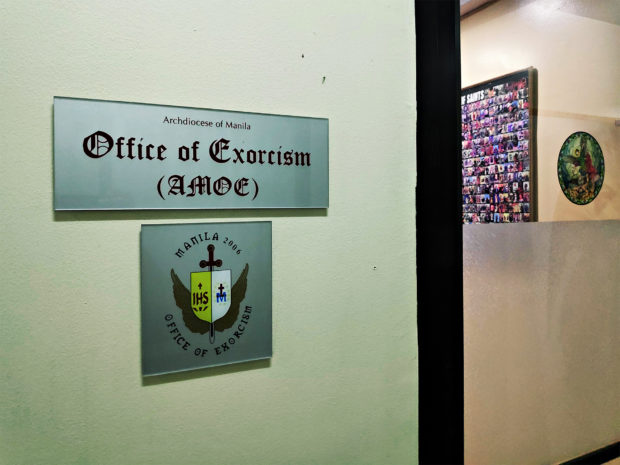
The Office of Exorcism of the Archdiocese of Manila. Image: INQUIRER.net/Joseph Garibay
Fr. Jose Francisco “Jocis” Syquia knew he wanted to become a priest as early as third grade. He entered high school, then college, and for a while this vocation dissipated.
This was during the regime of the late President Ferdinand Marcos, he recalled, a time of social unrest that saw him and other student leaders involved in political activism. His foray into the New Age as a young man also led to his exploration of other religions, and in opening his “third eye.” By then, he already had plans to take up law, but was compelled to turn to his faith when he started experiencing diabolical harassments and attacks.
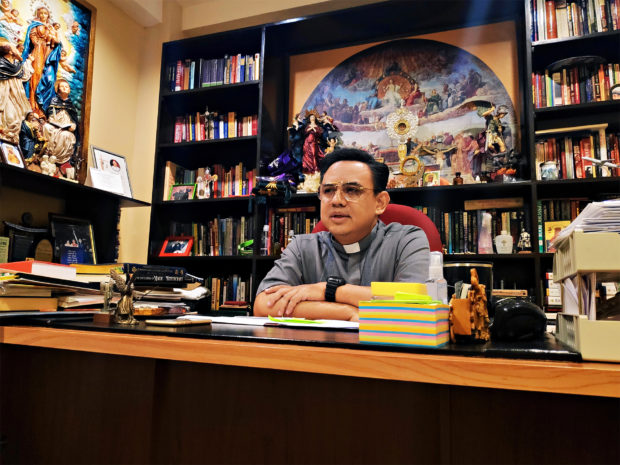
Fr. Jose Francisco “Jocis” Syquia. Image: INQUIRER.net/Joseph Garibay
“Every night I would see, before I would close my eyes, images of the devil. I’ve experienced a lot of harassments, even during the day, I would experience his presence,” said Fr. Syquia. “I would always feel cold. My body would really be always cold and I was afraid to sleep already and because of that, I turned to my Catholic faith in order to find help.”
He prayed more thereafter and began going to mass everyday, as well as regularly visited shrines and convents. The attacks and the nightmares stopped after around eight months. This was a turning point of his life, as discovering the reality of God’s presence reignited his childhood inclination to priesthood. And so, about a year later, he entered the seminary.
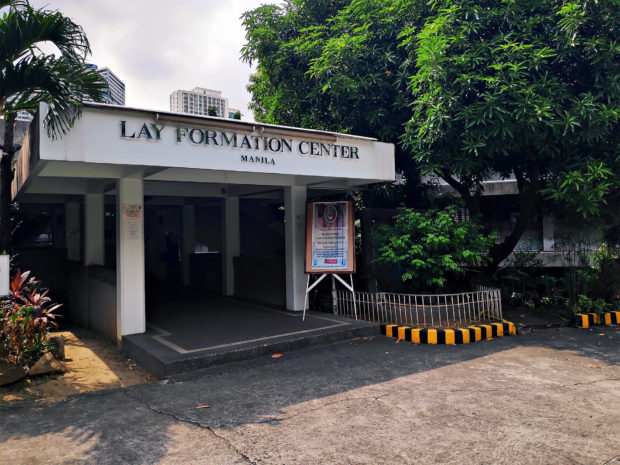
The Office of Exorcism of the Archdiocese of Manila, housed in the Lay Formation Center of the San Carlos Pastoral Formation Complex in Makati. Image: INQUIRER.net/Joseph Garibay
The Office of Exorcism of the Archdiocese of Manila
Article continues after this advertisementSyquia is the chief exorcist of the Office of Exorcism of the Archdiocese of Manila today. The office, housed in the Lay Formation Center of the San Carlos Pastoral Formation Complex in Makati, was established in 2006 in response to the growing cases of Filipinos in need of liberation or deliverance from demonic attacks. The office is composed of a team of exorcists, psychiatrists, psychologists, volunteers, and would also have priests sent by bishops from other dioceses for training.
Article continues after this advertisementThere are over 150 exorcists today in the Philippines, according to Syquia. They also have an association, the Philippine Association of Catholic Exorcists, which is under the Catholic Bishops’ Conference of the Philippines. The PACE is connected with the International Association of Exorcists in Rome, Italy, which was officially recognized by the Vatican in 2014.
Syquia, who also has a Master’s degree in Psychology, was given the faculty to practice exorcism by the now-retired bishop Teodoro Buhain in 2003. He had been assigned as a new priest in Quiapo church then, which is known to have a lot of occult practitioners in its vicinity.
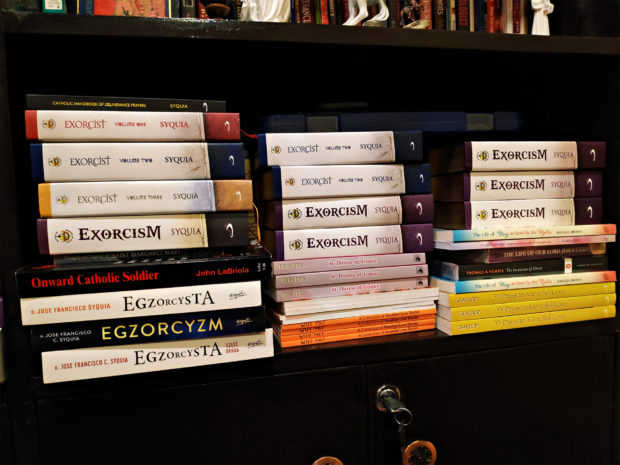
Books on exorcism at the office. Image: INQUIRER.net/Joseph Garibay
“People started coming, asking for help… And at first I didn’t want to deal with these cases precisely because of my previous experience with the devil,” said Syquia. “I didn’t want to have anything to do regards to him, but there was no choice because these are people asking for help.”
It was also around this time when Syquia chanced upon a book written by the late Fr. Gabriele Amorth, chief exorcist of the Vatican. Eventually, he went to Rome to study more about the ministry of exorcism and has been back and forth since 2008 to attend their courses.
“I saw how needed this ministry was especially today, how many people were seeking help from the church,” he said. “Therefore, reading [and] learning about him and his writings, it spurred me to learn more about it, para makatulong ako sa mga tao na lumalapit sa akin (so I can help the people who come to me).”
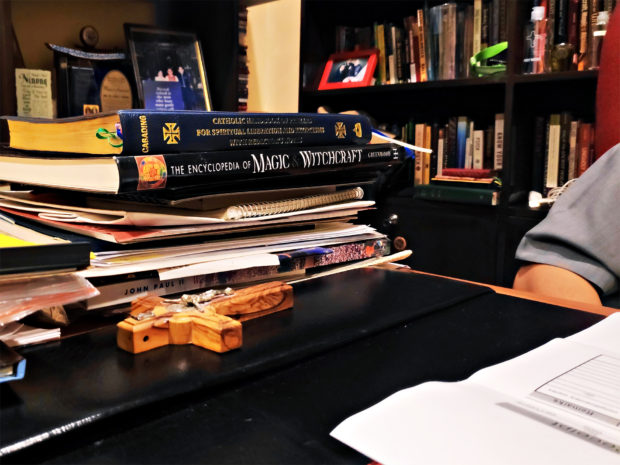
Books on exorcism at the office. Image: INQUIRER.net/Joseph Garibay
The ministry of exorcism and extraordinary demonic attacks
For the unknowing, Syquia explained exorcism as a ministry wherein Jesus himself expels evil spirits from a person through the instrumentality of a priest. By focusing on the expulsion of evil spirits, the ministry aims to reconnect or deepen a person’s relationship with God.
“As we see in the gospel, it is simply a continuation of this ministry of Jesus when he was doing exorcisms and it is given to a priest in the diocese,” he said. “It is a delegated office given by a bishop to a priest to be an exorcist, and this exorcist uses the Roman Ritual of Exorcism which is a manual of prayers that only an exorcist can pray over a possessed person.”
The office receives calls from three to five cases every day, but since there are already exorcists in other dioceses, the office refers the cases to their diocesan exorcists instead. Syquia added that they do not immediately perform an exorcism on a person and properly interview them first to determine if they are truly in need of deliverance from a demonic attack or psychologically ill.
He estimated that there is some spiritual dimension in around 80% of the cases they receive, while the other 20% is more psychological than spiritual. However, this is not always so black and white, as some cases are both spiritual and psychological at the same time.
“The devil doesn’t simply attack. If there’s a vacuum there, he cannot create, he cannot just possess a person or attack a person unless there are certain openings there,” he said. “So usually, [it is] if the person has some psychological vulnerability, psychic vulnerability, emotional vulnerability, relational vulnerability, but most especially, spiritual vulnerability.”
When it comes to the diabolical cases that they do accept, Syquia said that a huge percentage of these, around 30% to 40%, would be oppression. Oppression, he said, are diabolical attacks on the physical body of a person, as well as one’s emotions, mind and memory. These include kulam and barang, as well as bangungot.
“With cases that we have to pray over them and we exorcise the spirit, the spirit leaves through the expulsion of objects from the mouth of the person, like nails, mga pako, needles, pins…” he said. “Sometimes when you pray over them, the insects start to come out of their body like ants, sometimes sand, mga buhangin, that means these persons have been cursed.”
Another 20% would be infestation, such as haunted or manifested houses. These are usually places where the religious atmosphere is lacking, such as a home that has a lot of sin, abuse and relational problems among its members.
Twenty percent is also possession, which is the full takeover of a person’s body by a demon. A possessed person would be heavily under the power and bondage of a demon, who is able to control the person’s physical body. The person usually does not remember anything after being possessed, as if they were asleep or in a hypnotic trance.
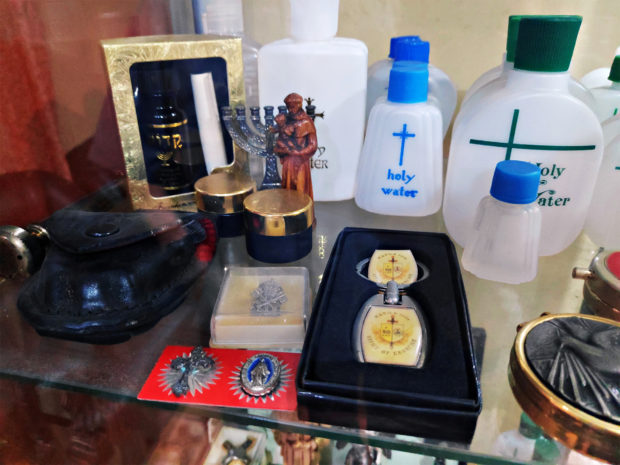
Materials and tools needed for an exorcism. Image: INQUIRER.net/Joseph Garibay
Cases of diabolical obsession make up the other 20%. It usually happens when a person would live in an infested house which would cause them to suddenly hear voices or have obsessive thoughts.
How Syquia differentiates a possessed person from someone who has a mental illness is a painstaking process in itself. To test if someone is possessed, Syquia said he would try to give a person holy water to drink. The person would usually suddenly vomit or be unable to drink the water, or if the person does, he or she would have a burning sensation in the throat. Syquia would also place a relic, a sacred object connected with a saint, nearby to see if the demoniac would react to it.
But what really determines if a person is possessed, he said, is when he recites the Roman Ritual of Exorcism, which is written in Latin.
“We start to use Latin when we command the spirit and usually we see the reaction there. When I command the spirit to manifest itself in Latin and the person starts to react there, nagkakaroon ng (the person starts to have) convulsions siya, then that means that there is something in the person that understands what I’m saying,” he said. “Or if I command it to tell its name while I’m speaking Latin and the person answers back and understands what I’m saying, that’s another indication.”
A possessed person usually becomes quite strong during pray overs, even if they are a young child. This is why there should be around seven people who take part in an exorcism, as others would have to help in holding the person down. Two are usually exorcists, although if there are priests in training, there would be three of the latter. Meanwhile, three to four laypersons are present to assist, while one or two family members may stay at the back of the prayer room. There is also a CCTV camera during exorcisms for times when a person would become too violent.
“[It] is also for our protection because sometimes, after the exorcism, may mga (the person would have) bruises yung tao ‘cause nagwawala yung tao talaga, malakas (because the possessed would be violent and strong), so we have to hold the person down,” said Syquia. “And therefore, the CCTV shows that what we’re doing is simply doing a pray over and we’re not touching the person in any violent manner, and the priest is simply touching, placing his hands, on the head of the person.”
A person then receives counseling after being exorcised, but just how long the aftercare would last depends on each case. Many of the cases the office receives are victims of sexual abuse, according to Syquia, and the demons could return again if there is a lot of hatred and unforgiveness. In these instances, counseling would be given to the person once or twice a month for almost a year. Others whose cases were not so heavy would usually have one or two meetings with a counselor before their cases are concluded.
“We call the person after one week, kamusta na siya (check up on how the person is doing), especially his relationship with the Lord, and the manifestations, the complaints and why the person came to us,” explained Syquia. “Pag wala na (If there would be no further incident) after one week, then one month wala pa rin (and there is still nothing), we close the case.”
What they make certain of in the end is for the person to reconnect or have an even deeper relationship with God, so the office introduces those who have been liberated to their respective parishes. These people, in turn, end up serving the church and becoming involved in its organizations and activities.
“We make sure the person, after the pray over, is still followed up,” he said. “Yung kaniyang relasyon sa Diyos ay mananatili, deepens, even, so that permanent talaga yung liberation.” (The relationship with God is maintained, it deepens even, so that the liberation would be permanent.)

A prayer to St. Michael the archangel. Image: INQUIRER.net/Joseph Garibay
State of exorcism in the Philippines
The more than 150 exorcists currently under the Catholic church are not enough to address the rising cases of demonic attacks in the Philippines, especially now, more than ever, when many Filipinos no longer live faith-filled lives, Syquia explained.
“We have so many broken homes, there’s a lot of unforgiveness, negativity now,” he lamented. “There are so many broken relationships, dysfunctional families. We see a lot of hatred and violence, and I mean, there are so many people [who] are wounded spiritually [and] emotionally.”
Around 86% of the Philippine population is Roman Catholic, according to non-profit educational organization Asia Society, thus making the country one of the biggest Christian nations in Asia. This, perhaps, is the irony here, as Syquia believes that only a very few truly live out their Christian faith.
“One [exorcist] reported in our last conference that in one year, he had around 500 cases and that’s a lot, and we’re talking about possession,” he said. “We’re not only talking about lesser forms of extraordinary demonic attack like oppression or obsession, these are possession [cases].”
It is a good thing, then, that there a number of young seminarians who have expressed their interest in the ministry of exorcism. Some seminaries in the country have also started opening courses on exorcism and deliverance so Filipino priests and seminarians would no longer have to go to Rome for training.
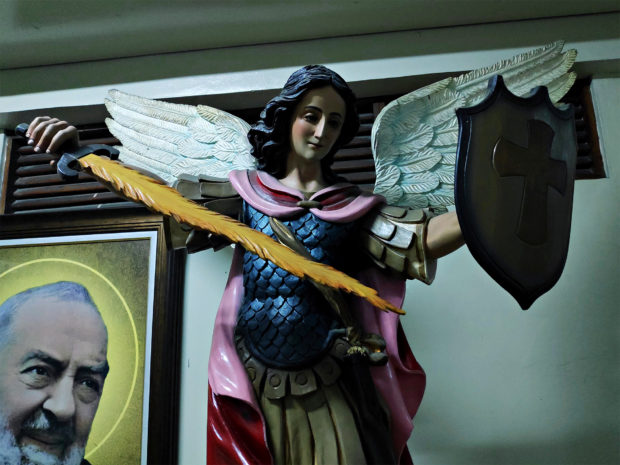
St. Michael the archangel battled Lucifer the devil, according to the Catholic faith. Image: INQUIRER.net/Joseph Garibay
Fear is surmised to be one of the main reasons why many priests do not want to go into exorcism, as Syquia shared that they were not taught about the devil and the ministry during his time in the seminary.
“The difficulty there is sometimes the priest, because we have not studied this and not really trained for it, medyo natatakot sila (they are a bit afraid),” he said. “But it’s more of lack of information, they don’t really know what to do.”
What is also lacking today, he believes, is the proper catechism or proper teaching of the Catholic faith, particularly when it comes to the spirit world, the spiritual life and the devil. Thus, proper dissemination of information regarding demonology and angelology is not just crucial, but necessary.
Syquia no longer feels afraid of the devil, but it seems that even this fearlessness did not come instantly, as he remembered wanting to quit within two years of becoming an exorcist in 2003. Being the only exorcist in the Philippines then, he almost buckled as the work of the ministry seemed too heavy for just one man. Then there was the bit of excitement in witnessing the preternatural in the beginning, which is itself momentary. Almost two decades on and countless of cases later, much of the ministry’s work has become routine for Syquia, but why exactly he continues to stay never differed from the very reason he entered the practice in the first place.
“I cannot leave the ministry if there are people who are still seeking help from this type of ministry. Now, if there’s no more need, then I’ll focus on my more normal priestly duties,” said Syquia. “No exorcist really desires this ministry. He simply accepts it because people come to him and he has to know how to deal with this. As [priests], we bless, we journey, but we also have to protect the flock.” JB
RELATED STORIES:
Of Filipino horror movies, a video rental shop, and our need to scream
North Cemetery’s 73-year-old gravekeeper is too busy feeling grateful about her job